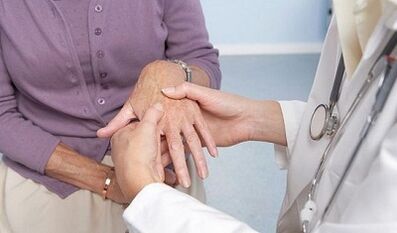
Diseases of arthritis and arthrosis are often confused because of the similarity of the names. Yes, and both diseases are affected by the joints (such as arthritis and osteoarthritis of the knee). Affected joints become inflamed, swollen and sore. Anyway, these are completely different diseases. Let’s try to figure out how arthritis differs from arthrosis?
Difference between arthritis and arthrosis
Arthritis is associated with inflammation of the joints, which in turn leads to impaired motor functions. The patient experiences discomfort, acute or aching pains during both physical activity and rest, especially in the morning. The skin around the joint swells, turns red and tightens. Body temperature often rises. Arthrosis is a disease in which degenerative processes occur in the articular cartilage. The altered cartilage ceases to cope with the load on them and is gradually destroyed. The pain caused by the effort usually goes away at rest. The tissues around the joint swell and become inflamed. Progressive disease leads to the destruction of cartilage and severe deformity of the joints. The difference between arthrosis and arthritis lies in the causes of the diseases. Arthrosis occurs:
- is associated with primary, usually old age;
- secondary, resulting from another disease or genetically determined.
The predisposing factors for the development of arthrosis are:
- overweight;
- excessive physical activity (most commonly in athletes) or very low physical activity;
- past injuries;
- endocrine diseases.
Arthritis is inflammatory. The disease has causes such as:
- various infections;
- joint damage and repeated minor injuries;
- metabolic disorders;
- allergy;
- lack of trace elements and vitamins.
Analysis of arthritis and arthrosis
For early diagnosis of diseases affecting the support device, the practitioner should collect a complete medical history. The patient is asked to perform the following tests and perform the specified tests:
- Clinical blood test to determine the level of ESR (with arthritis, the rate of erythrocyte sedimentation increases significantly, with arthrosis approaching normal).
- Biochemical blood test to identify the lack of macro- and micronutrients characteristic of arthritis.
- X-ray to detect bone deformities inherent in arthrosis and to determine the width of the joint space.
- MRI (magnetic resonance imaging), which allows changes in cartilage tissue to be identified in the early stages of the disease.
The cause of the disease
The main difference between arthritis and arthrosis is the origin of the diseases. Arthritis is an infectious disease that causes arthritis. Arthrosis is a degenerative process that occurs in the body due to the natural wear and tear of the joints, which causes the destruction of the cartilage layer in the joint. Therefore, arthrosis is primarily characteristic of the elderly, and arthritis can become infected at any age, even in childhood. Women are more likely to have arthritis. Osteoarthritis affects both women and men of old age. The most common causes of arthritis are:
- various infections;
- allergic reactions;
- joint damage;
- common minor injuries;
- physical stress;
- metabolic disorders;
- lack of vitamins and minerals;
- autoimmune disorders;
- diseases of the nervous system.
In addition, arthritis often develops as a complication of arthrosis, but not the other way around. Osteoarthritis mainly comes from:
- genetic predisposition;
- insufficient blood supply and bone nutrition;
- excessive stress on the joints;
- joint injuries;
- hypothermia.
Symptoms of joint disease
Although both diseases are accompanied by painful feelings, these feelings occur under different circumstances. In arthritis, pain occurs during both physical exertion and sleep and in the morning. In arthrosis, pain only worries a person during physical exertion.
Another characteristic difference between arthritis and arthrosis is the nature of the pain. Arthritis is characterized by sharp, severe, and twitching pain, and arthrosis is dull and painful, accompanied by cracking.
Arthritis most often affects the small joints, arthrosis - the large joints (especially the knees and hips). Arthrosis only affects the joints. In the case of arthritis, the inflammation can spread to several joints as well as other organs. In addition, arthritis is accompanied by fever, swelling and redness in the affected area. Sometimes, with arthritis, subcutaneous rheumatic nodules appear. Over time, arthrosis leads to deformities of the joints that can become thinner and take on strange shapes.
Diagnostics
Similar methods are used for diagnosis (X-rays, computed tomography, laboratory tests), but their results differ. In arthritis, a complete blood count increases the rate of erythrocyte sedimentation and high concentrations of C-reactive protein, leukocytes, and seromucoid. In the case of arthrosis, such an analysis does not detect any discrepancies.
Treatment of arthritis and arthrosis
Various professionals deal with the treatment of diseases. Arthrosis is treated by an orthopedic traumatologist, and in the case of arthritis, the cause of the disease is first determined and then a specialist is chosen depending on it. Diseases are treated in the same way, with medication and physiotherapy. If the disease has gone too far, surgery is used - endoprosthetics or joint replacement. But there are also some differences in the treatment of diseases. Arthritis requires immediate and active therapy, and arthrosis requires long-term and thorough treatment. The treatment of arthritis begins with a change in diet and lifestyle. The patient is then prescribed anti-inflammatory drugs and antibiotics as well as physiotherapy procedures. Osteoarthritis is treated with hormonal, anti-inflammatory and analgesic drugs. Arthritis usually heals completely, and arthrosis, a chronic disease, has irreversible consequences in the joints that cannot be treated - only degenerative processes can be slowed down.
These two consonant diseases are similar in their symptoms of rheumatism. However, do not confuse: arthrosis is a mechanical disease, and with arthritis, the joints become inflamed. Simply put, if the sore joints are swollen, the patient suffers from arthritis. If the joint pain is mild, it is arthrosis. In this article, we will try to explain in an accessible language how they differ. For those unfamiliar with medicine, it is difficult to distinguish the two. Because both diseases are directly related to rheumatism. Both diseases cause pain and discomfort in the joints that become immobile. The symptoms of these diseases as well as the ways to treat them are very different.
What is the difference between arthritis and osteoarthritis?

The difference between arthritis and arthrosis is that with arthritis, the joints become inflamed. As a result, the enzymes are released, leading to their destruction. They form proteins that hold them together. This is one of the causes of pain. It most often occurs when a person is asleep. With physical exertion, it subsides slightly. Weakness is felt in the morning. This disease affects the joints of the legs and arms.
There can be various causes of arthritis. For example, septic arthritis is caused by infection and rheumatoid arthritis is caused by a decrease in immunity. Gout is caused by metabolic disorders.
Joint changes occur along with physiological changes. As a result, the skin may become warm or red.
How is arthritis treated?
Healing requires relief of symptoms and restoration of joint mobility. It is recommended to try different methods for this. They can be combined if necessary. This will help you determine which one works best. With these diseases, the results of the blood test also differ. In arthrosis, protein levels increase. If the patient has arthritis, there is no change in the composition of the blood. The type of disease should be taken into account when selecting a drug to relieve such problems. Most commonly used for healing:
- corticosteroids;
- biological and anti-inflammatory drugs;
- analgesics;
- irritant drugs;
- antirheumatic drugs;
- therapeutic methods.
Healing requires physical activity. You can strengthen your joints and keep your muscles in tone with special exercises. Sometimes staples or rails are used for this purpose. If other methods of therapy do not help, doctors recommend removing the damaged joints. They are replaced by artificial ones. The knees are most often treated this way. Such an operation is performed to alleviate the discomfort and restore their activity. After this procedure, the destruction of the joints is slower. In addition, surgery is usually performed to excise the joint tissue. At the same time, the foreign particles are removed from their shells. Patients undergo such operations to smooth rough surfaces and change the pressure angle.
How is arthrosis treated?

To cure the disease, you need to reduce the risk factors. Overweight people are advised to eat properly. Patients should monitor their diet. This is especially true for those who have undergone surgery for pathology of the bone structure.
If the patient's condition does not improve, anti-inflammatory drugs and painkillers can get rid of the problems. In order not to have to use a prosthesis, the patient should prescribe hyaluronic acid. It also helps alleviate the inconvenience.
You should not completely reduce physical activity. Exercise should be easy for your health. This can prevent weight gain. If you suspect a particular disease, don’t panic or try to treat it yourself. Timely diagnosis and properly prescribed treatment increases the chances of a speedy recovery.
The main differences
As mentioned above, arthrosis is a mechanical disease. With it, the articular cartilage shrinks periodically until it disappears. As a result, the rubbing bones are exposed. It occurs mainly in the elderly. In this case, patients note certain characteristics associated with the appearance of the joints. It is usually associated with injuries, bone structure abnormalities and obesity for the following reasons. It most commonly affects the joints of the pelvis and knees. It often damages the joints of the neck and spine. Unlike arthritis, arthrosis can cause significant discomfort while moving. The discomfort goes away from walking, running, etc. Between. But apart from unpleasant feelings, it is not able to manifest itself in the form of inflammation, so it is often called a "cold" disease.














































